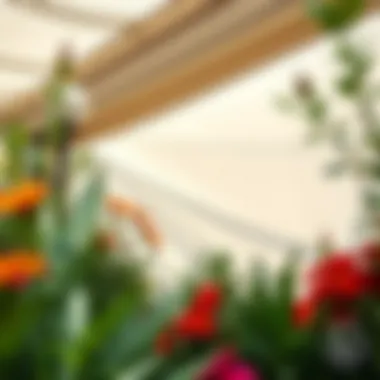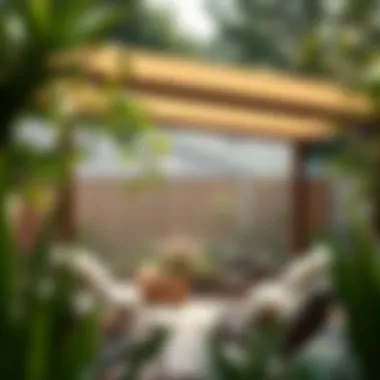Maximizing Garden Comfort with Effective Sun Shields


Intro
In today’s fast-paced life, gardens often serve as a sanctuary away from the hustle and bustle. Yet, the sun, while essential for plant growth, can also be a formidable adversary. An intense sunlight can wreak havoc on delicate blooms and create uncomfortable outdoor conditions. This is where sun shields come into play—acting as both guardians and enhancers of garden spaces.
By delving into how sun shields operate, the various materials available, and the methods for proper installation, we can uncover their vital role in gardens. Whether you're a homeowner seeking to maintain the health of your plants, an interior designer looking to integrate nature into your designs, or just someone who loves to dig into a bit of gardening, understanding sun shields can illuminate your path to a more inviting outdoor area.
Here's a look at the key aspects we’ll explore:
- The different types of sun shields available and how they cater to specific garden needs.
- Effective methods for installation and maintenance.
- Tips to combine sun shields with other elements in your garden for an aesthetic appeal.
In short, this article aims to equip you with the knowledge to make informed choices that promote plant vitality and enhance outdoor beauty.
Understanding Sun Shields
In the realm of gardening, sun shields stand out as vital components. They not only provide solace from harsh rays but also offer significant benefits to plant health and overall garden aesthetics. Understanding what sun shields are, their historical context, and their multifaceted purposes is essential for anyone looking to enhance their outdoor space. This section sets the stage for appreciating the nuances of sun shields and lays the groundwork for further exploration of various designs and installations.
Definition and Purpose
Sun shields refer to a diverse group of structures designed to protect against sunlight. These can vary from simple fabric canopies to more complex installations like pergolas. The primary purpose of these shields is to provide shade, reducing the temperature in gardens and helping to prevent plants from becoming scorched. Not only do they serve as protection, but they also foster a more comfortable environment for outdoor activities, making gardening, socializing, or simply relaxing in the garden much more enjoyable.
Additionally, sun shields can help with:
- Preventing UV Damage: UV rays aren’t just harmful to skin; they can also damage plants. Shielding them can improve their health and longevity.
- Temperature Regulation: By blocking direct sunlight, sun shields can significantly lower the heat in localized areas.
- Enhancing Aesthetic Appeal: With a variety of designs, sun shields can add a stylish touch to a garden space, creating focal points that please the eye.
- Increased Usability: They transform gardens into usable spaces at any time of day, regardless of harsh sunlight.
Historical Context
The use of sun-blocking structures goes back centuries. Ancient civilizations, like the Romans and the Egyptians, constructed awnings and canopies in their gardens to provide shade and comfort during hot days. In fact, the initial purpose of these structures was not only functional but also social, as they provided spaces for leisure and gatherings just as today.
Fast forward to the more recent past, and we see innovations in materials and designs. In the 19th century, as outdoor living became more popular, designs evolved with an increased emphasis on aesthetics. The Victorian era embraced elaborate garden structures that not only offered shade but also displayed architectural finesse. Today, with advancements in technology and materials, the options for sun shields are more diverse and effective than ever.
In summary, understanding sun shields is about recognizing their practical benefits and historical significance. They are not merely accessories; they are essential elements that can shape a garden's environment and experience. This foundational knowledge will serve as the backbone as we delve into the various types available, their effectiveness, and how to choose the right one for your needs.
Types of Sun Shields
Understanding the variety of sun shields available is crucial for homeowners and garden enthusiasts alike. Each type of sun shield brings unique benefits and considerations, making it vital to explore them in detail. Whether you're looking to enhance garden aesthetics or protect your plants from harsh rays, choosing the correct type can significantly impact your outdoor experience.
Fabric Canopies
Fabric canopies stand as one of the most flexible options for sun protection. These structures offer a broad range of colors, designs, and sizes, making them ideal for personalizing any garden space. The fabric is generally made from UV-resistant materials that not only shade your plants but also add texture and interest to your outdoor space.
Some notable benefits include:
- Versatile Application: Can be hung from trees, mounted on poles, or attached to existing structures for varying coverage.
- Cost-Effective: Compared to permanent options, fabric canopies typically come at friendlier prices.
- Easy Installation and Removal: When the seasons change or the sun's angle alters, these canopies can be adjusted or removed with little hassle.
However, consider the weather conditions in your area. In strong winds, fabric canopies are prone to wear and tear. So, keep an eye on the forecast!
Shade Sails
Shade sails have rapidly gained popularity in garden designs for their modern aesthetic and efficiency. These triangular or rectangular pieces of fabric are tensioned between mounting points, creating shady spots that are both stylish and pragmatic.
What makes shade sails a compelling choice?
- Durability: Typically made from heavy-duty, fade-resistant materials, they are built to last through the wrath of nature.
- Design Versatility: Available in various colors and shapes, shade sails can complement any style, from contemporary to rustic.
- Maximized Airflow: Unlike solid structures, shade sails allow for airflow underneath, keeping the area cooler.
One thing to keep in mind is proper installation—angles matter. If not installed correctly, water can pool on top and cause damage.
Retractable Awnings
Retractable awnings offer a perfect combination of functionality and flexibility. They allow homeowners to control the amount of sunlight filtering into their gardens or patio areas, which can be particularly useful in transition periods from spring into summer.
Key features of retractable awnings include:
- Adjustable Coverage: You can extend or retract them based on the season or time of day.
- Space Efficiency: Unlike permanent structures, they take up minimal space when not in use.
- Energy Efficiency: By blocking sunlight during peak hours, they help in cooling the interior of nearby homes, reducing reliance on air conditioning.
Although they offer numerous advantages, be mindful of potential wear over time. Regular maintenance checks will extend their lifespan.
Pergolas and Gazebos
When it comes to long-term structures, pergolas and gazebos provide both shade and a focal point in the garden. These additions don’t just offer protection from the sun; they also enhance the overall aesthetic appeal of your space.
Here are some reasons to opt for these structures:
- Integrated Design: They can be harmoniously integrated with surrounding landscapes, adding an artistic element.
- Permanent Features: Unlike fabric or sails, these structures are built to last, providing coverage for many seasons.
- Multi-Functional Space: They can serve as a gathering area, a dining space, or a quiet retreat to read.
It’s important to consider the material selection. Wood gives a natural look but may require more upkeep. Metal and vinyl options tend to demand less maintenance.
DIY Options
For those who enjoy some hands-on work, DIY sun shields can be a rewarding endeavor. Whether using simple materials or more elaborate setups, the satisfaction of creating your own sun protection can’t be understated.
When contemplating DIY options, keep these points in mind:


- Cost-Effectiveness: Often, DIY structures can be created from existing materials, keeping costs down.
- Personal Touch: You have complete control over design and functionality tailored specifically for your space.
- Flexibility: Certain projects can be easily modified or relocated depending on the changing seasons or preferences.
Popular DIY solutions might include using old sheets or tarps stretched tightly across frames or even building a trellis covered with climbing plants for a natural look.
The type of sun shield you choose can dramatically affect not only your garden’s appearance but also its health and comfort. Think of your garden as a canvas—each choice a brushstroke towards a masterpiece.
In summary, exploring various types of sun shields reveals their distinct advantages and helps homeowners make informed choices. Choosing the right design can create a harmonious balance between beauty and practicality in your outdoor spaces.
Factors Influencing Effectiveness
When it comes to sun shields in garden spaces, their effectiveness hinges on several critical factors. Integrating the right elements and understanding these considerations ensures optimal functionality of your sun shields. After all, using a sun shield isn't just about throwing some fabric over a structure; it’s about science, placement, and a dash of horticultural know-how—elements that play vital roles in achieving your desired garden vibe.
Material Quality
Fabric and materials used to construct sun shields bear heavily on their performance and longevity. Not all materials are equal, and the choice can make or break the guard against those harrowing UV rays. Quality fabrics like Solution Dyed Acrylic stand out in boasting heartiness against color fading and tearing, which is pivotal for long-term use, especially in vibrant garden spaces.
- Durability: Stronger materials resist wear and tear, especially during harsh weather conditions.
- UV Protection: Not all fabrics are designed to block UV rays effectively; some let through harmful rays, which weeds out the purpose of having sun shields.
- Breathability: Certain breathable textiles help maintain airflow and temperature, benefiting both plants and people.
Another aspect to consider is the craftsmanship. Homeowners should ensure that their investment is made with care, for instance, a poorly stitched canopy can unravel faster than you can say "green thumb." Taking the time to investigate material sources and upsides can save gardeners a hefty price later.
Angle and Positioning
The angle at which a sun shield is installed plays a pivotal role in determining how effectively it blocks sunlight. Simple physics govern this principle. For instance, if the structure is set too steeply, it might not provide the necessary coverage as the sun moves across the sky. Conversely, a more shallow angle could allow excess sunlight to creep under the shield, defeating the purpose.
Consider these factors:
- Sun Movement: Track the sun’s path in your specific garden. Knowing its trajectory can help in adjusting angles for maximum coverage.
- Plant Placement: Understand which areas require more shade based on your existing flora. Certain plants thrive in partial shade, while others need full sun.
- Seasonal Adjustments: As the sun shifts during seasons, adjust your sun shields periodically for consistent coverage.
Positioning sun shields to complement both the angle of sunlight and your garden’s layout makes a significant difference. This may require some trial and error but can lead to a harmonious balance that benefits both growth and aesthetics.
Climate Considerations
Every garden comes with its own set of climate characteristics that can sway the efficacy of sun shields. Regions with extreme heat might need heavy-duty, tightly woven fabrics to endure the scorching rays, while humid and temperate zones may benefit from lighter, more breathable materials. Knowing your climate type can guide your decision-making process.
Here are key climate aspects to bear in mind:
- Humidity Levels: High humidity can result in mold and deterioration. Look for materials resistant to moisture on top of UV protection.
- Wind Patterns: Areas that experience strong winds will need sturdier installations and secure anchor points to withstand gusts, preventing your shield from becoming an oversized kite.
- Rainfall: In some climates, prolonged rain might necessitate waterproof fabrics, which can extend the lifespan of your investment while keeping your garden thriving.
Understanding these climate nuances fosters informed decision-making about sun shield types and placements, allowing gardeners and decorators alike to create the spaces they envision while nurturing their plants effectively.
"An effective sun shield is a marriage of material, angle, and climate; neglected issues can quickly lead to a mismatched partnership that yields disappointing results."
By integrating these key factors—material quality, angle and positioning, and climate considerations—homeowners can significantly enhance the efficacy of sun shields in their garden spaces. With thoughtful planning, the overall gardening experience transforms into a vibrant, flourishing oasis.
Benefits of Implementing Sun Shields
Implementing sun shields could be one of the best decisions a homeowner makes. Not only do these structures provide immediate relief from the sun, but they also bring a multitude of benefits which can improve the overall environment of a garden space.
When thinking about the right sun shield, it's important to consider factors like the climate, the plants' needs, and the overall aesthetics of the garden. A sun shield doesn't just act as a physical barrier against sunlight. Instead, it creates a microclimate that can enhance the health and longevity of plants while also making a space more enjoyable to use during warmer months.
Protection from UV Rays
One of the standout features of sun shields is their ability to block harmful UV rays. Gardens are often places of relaxation and cultivation, yet many gardeners might underestimate the impact of prolonged sun exposure. UV rays, particularly during peak hours, can damage delicate skin and pose serious health risks.
Key points on UV protection include:
- Shielding Plants: Certain sun shield materials can absorb or reflect UV rays, protecting plants from scorching and extending their blooming periods.
- Safety First: By using sun shields, you can ensure that family and friends enjoy the garden while minimizing sunburn risk.
By integrating sun shields, you're not just safeguarding yourself; you're also creating a healthier space for all life forms, plants included.
"A garden sun shield acts like a warm hug on a hot day, overlapping personal comfort with vital plant care."
Temperature Control
Temperature regulation is essential for garden health. Without properly managing heat exposure, the entire garden can suffer from heat stress, which can lead to withering plants, metered water usage, and a less enjoyable environment for outdoor activities. Sun shields play a pivotal role in temperature management.
Benefits of temperature control:
- Cooling Effect: Sun shields can lower the ground temperature in garden areas, creating a cooler environment that promotes growth, particularly for shade-loving plants.
- Water Conservation: With less evaporation from soil due to indirect sunlight, you can maintain soil moisture more efficiently, leading to decreased irrigation costs.
When temperature control is in check, plants can thrive and homeowners can enjoy their gardens for longer stretches of the day without the relentless heat wearing them down.
Enhancing Garden Aesthetics
Beyond practical benefits, sun shields can be a game-changer in terms of aesthetics. Whether it's a sleek aluminum pergola or a beautifully draped fabric canopy, these structures can complement a garden's overall look, making it all the more inviting.
Considerations for aesthetics:
- Diverse Designs: There are numerous styles of sun shields available that can fit various themes, from rustic to modern. This flexibility allows homeowners to get creative and personalize their garden space.
- Creating Dimensions: Properly placed sun shields can break the monotony of flat spaces, adding depth and dimension to the layout.
By choosing the right sun shield, you're not just providing sunshine protection; you're adding an artistic touch to your sanctuary.
Choosing the Right Sun Shield


Selecting the proper sun shield for your garden can mean the difference between a thriving outdoor space and a lackluster one. Sun shields go beyond aesthetics; they play a crucial role in optimizing your garden’s unique microclimate, providing essential protection for both plants and the people enjoying the space. Whether you are looking to shield delicate flowers from the scorching sun or create a comfortable lounging spot, understanding how to choose your sun shield is key.
Assessing Your Garden’s Needs
Before diving headfirst into options, consider what your garden's specific needs are. Each garden is distinct, shaped by its local climate, plant species, and intended use. Answering a few guiding questions can clarify your decision.
- What’s the primary purpose? Is it merely for shade, or do you need to minimize UV exposure for certain plants? Knowing why you need a sun shield shines a light on the right choice.
- What plants are you shielding? Some species thrive in full sunlight, while others might wilt under its intensity. Familiarize yourself with the sun requirements of the plants in your garden.
- What is the layout and position of your garden? Take into account the sun's trajectory throughout the day and how different areas receive light. This can help determine your ideal sun shield arrangement.
By thoroughly assessing these variables, you can make an informed choice that aligns with your garden’s characteristics and needs.
Evaluating Various Designs
Once you understand your garden's requirements, it’s time to look at the designs available. Different styles of sun shields not only provide various levels of sun protection but also contribute to the garden's overall aesthetic.
- Fabric Canopies: These are flexible and can be adjusted to let some sunlight through, making them suitable for more temperate climates.
- Shade Sails: Available in many vibrant colors and shapes, shade sails can create a modern, artistic look while providing ample coverage.
- Retractable Awnings: For those who want something that adapts to their needs, retractable awnings offer both shade and sunlight when desired.
- Pergolas and Gazebos: These structures not only provide shelter but can also act as a decorative element within a garden setting.
Don’t overlook the practical aspects of these designs, like how they withstand wind or how easy they are to install and maintain. The right design for your sun shield can enhance both functionality and visual appeal.
Budget Considerations
Choosing a sun shield isn’t just about what looks good; your budget plays a pivotal role too. Sun shields come in a wide price range, and understanding your financial limits will help narrow down options significantly.
- Material Costs: Certain materials—like high-quality UV-resistant fabric—may cost more upfront but can save you in the long run with durability and maintenance benefits.
- Installation Expenses: If you're not a DIY enthusiast, consider the costs of hiring professionals for a custom setup. This can add significantly to the overall spending.
- Long-term Value: Think about how much you want to invest based on the lifespan of the sun shield. It may be tempting to go with the cheapest option, but if it needs replacing quicker, that initial savings might vanish into thin air.
Sticking to a well-defined budget allows you to focus on practical solutions while still finding something that meets both your functional needs and aesthetic desires.
Remember, a sun shield is not just a purchase; it’s an investment in your garden's comfort and beauty.
Installation Strategies
When it comes to sun shields, installation strategies are the bedrock of their effectiveness and longevity. A well-planned installation not only enhances the performance of the shield itself but also ensures that your garden benefits fully from the shade created. In this section, we will dive into the critical elements of setting up your sun shields, discussing site preparation, anchor options, and maintenance access. A cautious approach can lead to a garden oasis that thrives under its protective canopy.
Site Preparation
Preparing the site is akin to laying down the groundwork for a house—without it, everything is likely to crumble. Before you even think about putting up a shade structure, it’s essential to evaluate the area where you intend to install your sun shield.
Considerations in Choosing the Right Area
- Sun Patterns: Observe how sunlight hits the area throughout the day. Doing this may reveal spots that receive prolonged exposure or afternoon glare, allowing you to place your shield in a way that maximizes shade.
- Access to Plants: Ensure that the sun shield installation won’t obstruct growth or access to your beloved plants. You want to create an environment conducive to thriving plants without creating shade where it’s not needed.
- Soil Conditions: If you’re mounting something like a pergola or heavy gazebo, the ground has to be solid. Check for any rocky areas or loose soil that might undermine the stability of your anchors.
Proper site preparation saves a heap of trouble down the line, preventing you from having to redo work because it wasn’t thought out well from the start.
Anchor Options
The choice of anchors plays a pivotal role in ensuring that your sun shields remain steadfast against the elements. Using the right anchor options can drastically affect stability and safety, especially in windy conditions.
Types of Anchors to Consider
- Concrete Footings: For permanent structures, concrete footings can provide a solid foundation, helping to keep your install securely in place for years to come. Expect to pour concrete for this option, but it will pay dividends in stability.
- Ground Anchors: If you want the flexibility of being able to remove a structure seasonally, ground anchors are a good choice. These can be secured into the ground with little fuss and can handle moderate windage without budging.
- Weight Bags: For temporary setups, weight bags filled with sand or gravel can hold your sun shield in place. While this method is easier to manage, be cautious during severe weather as they can be displaced.
Maintenance Access
Even the best-planned installations require occasional attention. Therefore, considering maintenance access during the installation phase is crucial. A sun shield that is hard to reach will lead you to neglect, and in time, effects can be damaging.
Creating Maintainable Access
- Strategic Design: Design your installation with enough space around it. This allows easy access and doesn’t restrict movement even when performing maintenance tasks.
- Height Matters: If possible, keep structures lower to the ground or adjustable. This is particularly beneficial when cleaning or inspecting for damage.
- Detach and Reattach Ease: Look for designs that allow you to easily take down or adjust the sun shield for seasonal changes; this makes maintenance a breeze and keeps your garden adaptable to changing weather.
In sum, investing time and thought into installation strategies paves the way to a flourishing garden space that benefits from the protective shade provided by sun shields. By prioritizing thoughtful site preparation, solid anchor choices, and easy maintenance access, you set the stage for a garden that thrives.
Remember, an ounce of prevention can save a pound of regret. Making informed choices during installation will ensure you enjoy your sun shields for many seasons to come.
Maintenance of Sun Shields
Taking care of sun shields goes beyond occasional cleaning; it’s about preserving the very essence of what makes them valuable in garden spaces. Regular maintenance can enhance their lifespan, ensuring you get the maximum benefit from your investment. When sun shields are well-maintained, they not only perform better but also add continuous aesthetic value to your outdoor environment.
Cleaning Recommendations
Keeping your sun shields clean is a priority. Dust, debris, and grime can accumulate, affecting their effectiveness and appearance. Here are a few recommendations for maintaining cleanliness:
- Use mild soap solutions: For fabric covers, a little soap mixed in water goes a long way. Avoid harsh chemicals as they can degrade the material.
- Soft brushes: A soft-bristled brush or sponge can help scrub away dirt without causing damage. For tougher stains, you might want to try specialized cleaning solutions designed for outdoor textiles.
- Rinse properly: Always rinse off any soap residue with plenty of water. This prevents potential discoloration or stickiness due to leftover soap.
- Regular intervals: Set a cleaning schedule—monthly is a good starting point, especially after heavy storms or pollen seasons.
Seasonal Checkups
As seasons change, so do the challenges posed to your sun shields. Regular checkups can preemptively catch wear and tear. Here are the strategic points to pay attention to:
- Spring Cleaning: Prior to the onset of heavy use, assess the physical state of your sun shields. Look for signs of stretching, fading, or fraying.
- After Summer Storms: High winds and intense sun can lead to unexpected damage. After storms, check for rips or tears.
- Winter Preparations: If you live in an area with harsh winters, consider taking down fabric shields to prevent ice build-up that could stretch or tear them.
"A stitch in time saves nine."
This proverb rings true when it comes to sun shield maintenance; addressing small issues can prevent larger, more costly repairs later.
Repairing Damage


Even with diligent care, wear and damage can happen. Knowing how to tackle these repairs can save you time and expense in the long run. Here are some repair strategies you might consider:
- Sewing small tears: If you have fabric sun shields, keep a sewing kit handy. Small rips can often be stitched up easily before they become larger issues.
- Patch kits for fabrics: Many options are available in hardware stores designed specifically for outdoor fabrics. They can seal up tears without much effort.
- Re-tightening or replacing hardware: For structures like pergolas or awnings, inspect the frame and supports regularly. Loose screws or bolts can be re-tightened, while damaged components may need replacing.
Integrating Sun Shields with Other Elements
Creating a garden space that's not only functional but also aesthetically pleasing involves an understanding of how various elements interact with each other. This is where integrating sun shields with other components becomes critical. Sun shields, whether they be fabric canopies, shade sails, or pergolas, possess more virtue when combined with thoughtful choices in lighting, furniture, and landscaping. Maintaining comfort while accentuating beauty can transform an average outdoor area into a remarkable one.
Combining with Lighting
One of the first considerations when integrating sun shields with other elements is the incorporation of lighting. Strategically placed lights can splendidly enhance the ambiance in garden spaces, making these areas usable even after the sun dips below the horizon.
When selecting lighting, consider the following options:
- String lights: These can be festooned across beams of a pergola or along the edges of a canopy, creating a warm glow.
- Spotlights: A focused beam can highlight relevant features of your garden, such as flowering plants or decorative elements.
- Solar lights: These are eco-friendly options, which can be installed without the hassle of wiring. They charge in daylight and automatically illuminate at night.
As you hang or position lights, maintain some distance from the sun shield fabrics. Too much direct heat can degrade the materials over time. Therefore, using LED lights or solar fixtures is generally advisable, ensuring both safety and longevity.
Pairing with Furniture
Furniture should not just fill the space; it needs to complement your sun shields harmoniously. Furniture provides utility but also contributes to the aesthetic and comfort of the garden. Sun shields can dictate the type of furniture you'll choose, based on the shade's pattern and the area covered.
Consider these points while selecting furniture:
- Material Compatibility: Metal or wood can withstand harsh weather better than rattan, which might fade under direct sunlight.
- Functionality: If hosting dinners or afternoon tea is on your agenda, having a sturdy dining set beneath a canopy would be functional.
- Color Harmony: Choose colors that enhance the look that your sun shield brings. For example, light pastels or white furniture accentuate a crisp, airy feel, while darker shades may add warmth.
Quotes from homeowners when pairing:
“The right furniture makes all the difference under the sun shield. It feels like an extension of my home.”
Landscaping Considerations
Incorporating sun shields in garden spaces should also go hand-in-hand with landscaping choices. The right plants and ground covers surrounding or even beneath your sun shields can magnify both the protective effect and visual delight.
Here are aspects to ponder:
- Plant Selection: Shade-tolerant plants, like ferns and hostas, thrive well under sun shields, ensuring greenery flourishes.
- Ground Cover: Consider ground covers such as creeping thyme, which thrive both in full and partial shade.
- Vertical Gardens: Using trellises or panels attached to the sun shields can expand your gardening options vertically, introducing more flora without taking up ground space.
The integration of these elements doesn't just enhance the overall aesthetic. It ensures a seamless flow of space, comfort, and beauty. By thoughtfully combining sun shields with strategic lighting, well-chosen furniture and effective landscaping, homeowners can transform their garden experiences. The goal is not just function but creating a haven where nature and manmade structures coexist beautifully.
Common Misconceptions
Misunderstandings about sun shields can leave garden enthusiasts scratching their heads. These misconceptions can also lead to poor choices in sun protection, which may not cater to their specific garden needs or climate. Being aware of these inaccuracies ensures homeowners and designers make informed decisions, maximizing the benefits that these protective structures offer.
Sun Shields Are Only for High Temperatures
A prevalent myth is that sun shields are only necessary during scorching summer days. However, this couldn't be further from the truth. While they certainly shine in warmer months, their value extends far beyond battling heat.
During cooler seasons or in regions where temperatures fluctuate, protective sun shields can still offer essential benefits. For instance, they help reduce the harsh glare that can affect delicate plants throughout the spring and even autumn. Additionally, a well-placed sun shield can create microclimates within a garden, allowing certain areas to remain insulated against chillier winds.
Furthermore, consider the role of sunlight intensity. On bright but cool days, too much direct sunlight can still harm plants, exposing them to stress or sunburn. Therefore, deploying sun shields year-round can be integral in maintaining the health of your garden.
All Materials Provide Equal Protection
Another misleading notion is that all sun shield materials offer similar levels of protection. Reality tells a different story. The type of material chosen plays a critical role in its effectiveness against harmful UV rays and the potential for heat absorption.
For instance, shade cloth made from high-density polyethylene provides a different level of shielding compared to traditional canvas. Some may block up to 90% of UV rays, making them far more effective in safeguarding plants. Others, like perforated materials, offer less protection but allow for air movement, which can be beneficial for certain types of flora.
In making a choice, consider:
- UV Protection: Look for materials with ratings that specify how much UV protection they offer.
- Breathability: Some fabrics allow for air circulation, reducing heat build-up.
- Durability: Weather resistance influences how well the sun shield lasts through seasons.
To sum it up, understanding the nuances of different materials can significantly impact both the aesthetics and health of your plant life.
"Misconceptions can lead to decisions that compromise a garden's health and beauty. Caution is paramount when selecting the right sun shield."
Choosing the right sun shield means weighing both need and material characteristics. It’s a journey toward ensuring your garden not only survives but thrives regardless of external conditions.
Future Trends in Garden Sun Shields
As the world continues to evolve, so do our approaches to gardening and outdoor living. In recent years, the need for innovative solutions that enhance the functionality and aesthetics of garden spaces has surged. This section will explore the future trends associated with garden sun shields, which cater to both the practical needs of homeowners and the environment.
Innovative Materials
The shift towards using advanced materials in sun shield manufacturing is notable. Fabric technologies are being developed to provide more effective UV protection while maintaining a lightweight and breathable nature. For instance, shade fabrics are being made with a higher denier, which improves durability and weather resistance. Companies are also experimenting with materials that change properties according to temperature or sunlight intensity. Imagine a canopy that adjusts its permeability as the sun rises or decreases its density, shielding you from harsh rays. These innovations don't only serve a functional purpose—they can also add to the aesthetic appeal of garden designs.
Smart Technology Integration
In our increasingly connected world, smart technology is making its way into garden care. A lot of homeowners are on the lookout for features that simplify their gardening practices. New sun shields will integrate sensors that detect light intensity and temperature, automatically adjusting the shade position to optimize comfort for both plants and people. For example, an awning that retracts during the hottest parts of the day, only to extend again when temperatures cool off, could conserve energy and maintain an ideal garden microclimate.
Moreover, through smart home systems, users can remotely control sun shields. Picture this scenario: after a long day at work, you decide to unwind in your garden. With a few taps on your phone, you can set the sun shield to the perfect position before you even step outside.
Sustainability Practices
Sustainability is no longer a buzzword—it's a way of life that many are embracing wholeheartedly, especially when it comes to gardening. The future will likely see a rise in sun shields made from recyclable or sustainable materials, focusing on minimal environmental impact. For example, some manufacturers are starting to use recycled plastics and sustainably sourced wood in their structures. Additionally, innovative production methods that reduce waste or energy consumption are becoming more prevalent. This could signal a shift in consumer preference towards products that not only look good but also align with eco-friendly principles.
"Embedding sustainability into the design of garden elements not only enhances our outdoor experiences but also contributes positively to the environment."
In summary, the realm of garden sun shields is on the brink of exciting changes. Homeowners, interior designers, and other stakeholders in outdoor living may find that these innovations provide not just coverage but also redefine how we interact with our green spaces. Keeping an eye on these trends can open up new opportunities for creating functional, stylish, and sustainable outdoor environments.















